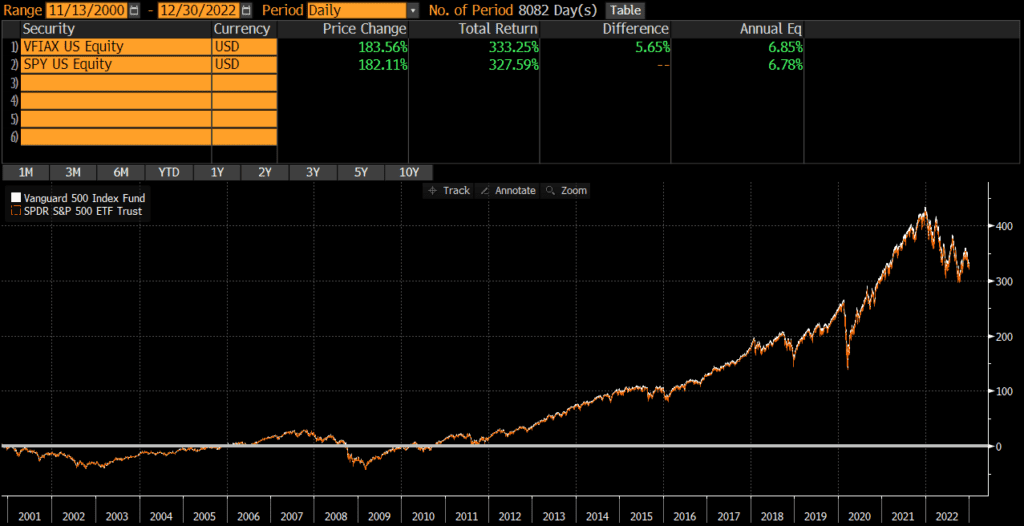The Vanguard S&P 500 Index Fund (VFIAX) and the State Street S&P 500 ETF (SPY) are two of the largest index mutual funds in existence and easily two of the most popular among individual investors. Both VFIAX and SPY track the well-known S&P 500 index and form the core of many investor portfolios. Many investors compare VFIAX vs SPY in order to decide which should be the foundation of their portfolio.
The Short Answer
The main difference is that VFIAX is a mutual fund and SPY is an ETF; however investors should consider several other factors when deciding which is best.
A quick reminder that this site does NOT provide investment recommendations. Fund comparisons (such as this one) are not conducted to identify the “best” fund (since that will vary from investor to investor based on investor-specific factors). Rather, these fund comparison posts are designed to identify and distinguish between the fund details that matter versus the ones that don’t.
The Long Answer
Historical Performance: VFIAX vs SPY
SPY was launched back in 1993, while VFIAX was launched a few years later in late 2000. Since their common inception date, the two funds have performed nearly identically, with a difference of just .07% annually! The cumulative performance difference between these two funds has been about 5% (over a 22 year timeframe)! Thus, from a performance perspective, I would consider these two funds interchangeable.

Differences between VFIAX vs SPY
Both VFIAX and SPY track the S&P 500, so I will not delve into differences in geographic exposures, sector weights, or market cap coverage. For all intents and purposes, the portfolios are identical with 504 stocks each. The S&P 500 has more than 500 stocks because of the index constituents have multiple share classes of stock (such as GOOG and GOOGL).
Factors to Consider
Transaction Costs
ETFs are free to trade at many brokers and custodians, including Vanguard. However, many brokers and custodians still charge commissions and/or transaction fees to buy/sell mutual funds. To my knowledge, Vanguard does not participate in the pay-to-play arrangements (with their competitor custodians) that would allow their mutual funds to trade for free on many platforms. So if an investor account is at Vanguard, it is generally free to trade VFIAX or SPY. However, only SPY is free to trade in many non-Vanguard accounts.
There is a bid-ask spread when trading ETFs, but this spread is typically less than .01% for SPY and individual investor trades will not generally be large enough to “move” the market. In the case of SPY, individual investors should not have a problem trading.
Tax Efficiency & Capital Gain Distributions
ETFs are typically more tax-efficient than mutual funds, due to their ability to avoid realizing capital gains through like-kind redemptions (a process that is beyond the scope of this post). However, many Vanguard mutual funds (including VFIAX) have an ETF share class that allows the mutual fund portfolio to enjoy the tax benefits of ETFs. So, in this case, VFIAX and SPY are equivalent in terms of tax-efficiency.
Tax Loss Harvesting
My personal preference is to keep a portfolio entirely mutual funds or entirely ETFs, due to the mechanics of settlement during tax loss harvesting. If an ETF has declined in value and an investor sells it, the trade and cash proceeds will not settle for two business days (T+2). That investor may want to “replace” the sold ETF immediately and attempt to buy another ETF or mutual fund simultaneously.
However, mutual funds settle on T+1 basis, so cash for the mutual purchase would be due in one business day (which is one day earlier than the cash from the ETF sale is received). This can obviously cause problems and (even though this issue can be addressed with careful planning) I find it easier to keep accounts invested in similar vehicles. In this case, if a portfolio is all mutual funds, I might lean more towards VFIAX. If all ETFs, I might lean more towards SPY.
On this topic, investors may want to avoid using these two funds as tax loss harvesting substitutes for one another since they could be considered “substantially identical.”
Tradability
VFIAX does not have a stated minimum for purchases, although some brokerages (especially competitors of Vanguard) impose minimums. The minimum purchase size for SPY is typically one share, although fractional shares are becoming more common. Investors can trade ETFs intraday, as well as in the pre-market and after-hours trading sessions. Investors can only buy/sell mutual funds once per day. This is not necessarily a major factor for long-term investors however.
Final Thoughts: VFIAX vs SPY
Both VFIAX and SPY are large, core funds sponsored and managed by Vanguard and State Street respectively. Performance has been nearly identical. I view VFIAX and SPY as essentially interchangeable and would not spend too much energy trying to decide which one is “better.”
However, there are some situations that may call for one fund versus another. For instance, many custodians offer free ETF trades, but charge trading fees or redemption fees for mutual funds. So I might select VFIAX or SPY solely based on where my account is held or whether I’m investing taxable vs retirement dollars. Despite these considerations, these two funds are very similar for all intents and purposes.